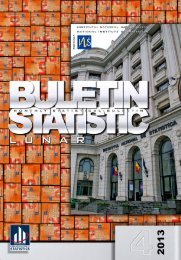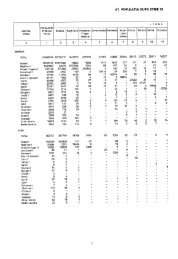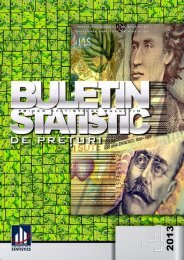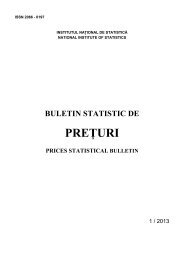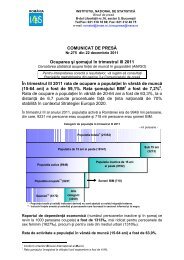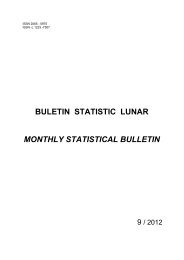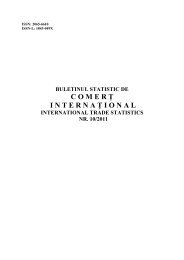• Rata şomajului reprezintă pondereaşomerilor, conform definiţiei internaţionale (BIM),în populaţia activă.• Populaţia activă din punct de vedereeconomic cuprinde toate persoanele carefurnizează forţa de muncă disponibilă pentruproducţia de bunuri şi servicii în timpul perioadeide referinţă, incluzând populaţia ocupată şişomerii.Metodologia de estimare aplicată se bazeazăpe metode econometrice care niveleazăexponenţial seriile de date cu tendinţă lineară.Valorile prognozate sunt derivate din datelefurnizate de cercetarea statistică asupra forţei demuncă în gospodării, pe baza unor coeficienţi denetezire, care corectează nivelul şi tendinţaseriei în formă brută (neajustată). Coeficienţii denetezire sunt determinaţi din condiţia minimizăriierorilor de previziune.Modul de prezentare al datelor: Datele dinaceastă publicaţie sunt prezentate în formăajustată sezonier, eliminându-se astfel şi efectulvariaţiilor sezoniere. Pentru ajustarea sezonierăs-a folosit pachetul de programe DEMETRA(metoda TRAMO/SEATS), care realizează şiestimarea efectul calendarului (Paştele ortodox,an bisect şi alte sărbători naţionale) precum şiidentificarea şi corectarea valorilor extreme(schimbări ocazionale de nivel, tranzitorii saupermanente). Estimarea componentelorneobservate: trend-ciclu, sezonalitate şicomponenta neregulată se realizează de cătreprogramul SEATS pe baza modelelor ARIMA.Seriile ajustate sezonier s-au obţinut prineliminarea componentei sezoniere din seriaoriginală. În baza de date TEMPO a INS(www.insse.ro ) sunt disponibile şi seriile de dateîn formă neajustată şi ca trend.Politica de revizuire a datelor: Indicatorii rataşomajului şi numărul şomerilor – conformdefiniţiei internaţionale (BIM) - sunt diseminaţilunar cu titlul de date provizorii şi fac obiectulreviziilor trimestriale, pe măsură ce noi informaţiidevin disponibile, astfel:• indicatorii cu perioadă de referinţă ianuarie,februarie şi martie se publică în variantăprovizorie la sfârşitul lunilor februarie, martierespectiv aprilie şi se revizuiesc în mai;• indicatorii cu perioadă de referinţă aprilie,mai şi iunie se publică în variantă provizorie lasfârşitul lunilor mai, iunie respectiv iulie şi serevizuiesc în august;• indicatorii cu perioadă de referinţă iulie,august şi septembrie se publică în variantăprovizorie la sfârşitul lunilor august, septembrierespectiv octombrie şi se revizuiesc în noiembrie;• indicatorii cu perioadă de referinţăoctombrie, noiembrie şi decembrie se publică învariantă provizorie la sfârşitul lunilor noiembrie,decembrie şi ianuarie (anul următor) şi se• The unemployment rate is the weight ofthe unemployed, according to internationaldefinition (ILO), in the active population.• The economically active populationcomprises all persons who provide the supply oflabour for the production of goods and servicesduring the reference period, including theemployed population and the unemployed.The estimation method applied is based oneconometric methods that exponentially smoothdata series that shows a linear trend. Theforecasted values are derived from the dataprovided by the Household Labour Force Survey,using smoothing coefficients that adjust the leveland trend of the series (in unadjusted form). Thesmoothing coefficients are determined byminimizing the prediction error.How the data are presented: Data in thispublication are released as seasonally adjusteddata. The effect of seasonal variations is henceremoved. For seasonal adjustment, theDEMETRA software package (theTRAMO/SEATS method) was used, which alsoestimates the calendar effect (Orthodox Easter,leap year and other national holidays) andidentifies and corrects the outliers (occasional,transitory or permanent changes in level). Theestimation of the non-observed components (thetrend-cycle, seasonality and the irregularcomponent) is made by the SEATS programmeon the basis of ARIMA models. The seasonallyadjusted series were obtained by removing theseasonal component from the original series. Inthe TEMPO online database of NIS(www.insse.ro ) the non-seasonally adjustedseries as well as trend series are also available.Data revision policy: The unemployment rateand the number of unemployed, according tointernational definition (ILO), are disseminatedon a monthly basis as provisional data and aresubject to quarterly revisions as new informationbecomes available, namely:• the indicators whose reference period isJanuary, February, March are published asprovisional indicators at the end of February,March, April and are revised in May;• the indicators whose reference period isApril, May, June are published as provisionalindicators at the end of May, June, July and arerevised in August;• the indicators whose reference period isJuly, August, September are published asprovisional indicators at the end of August,September, October and are revised inNovember;• the indicators whose reference period isOctober, November, December are published asprovisional indicators at the end of November,December, January (next year) and are revised210
evizuiesc în februarie - anul următor.Anual, odată cu publicarea datelor pentru primalună a anului, seriile în formă ajustată sezoniersunt revizuite integral ca urmare a reestimăriiparametrilor modelului ARIMA.Sursa datelor o constituie Cercetarea statisticăasupra forţei de muncă în gospodării (AMIGO) -care se realizează trimestrial, în conformitate cuRegulamentul Consiliului şi ParlamentuluiEuropean nr, 577/1998 cu privire la organizareaunei anchete statistice selective asupra forţei demuncă în Comunitatea Europeană şi modeluleconometric dezvoltat şi aplicat pentru estimareaşi prognozarea seriilor lunare.Cele două seturi de indicatori statistici caremăsoară şomajul (şomajul lunar - conformdefiniţiei internaţionale şi şomajul înregistrat) nusunt comparabile deoarece sursele de date,metodele de măsurare, conceptele, definiţiile şisfera de cuprindere sunt diferite. Analiza datelordin ambele serii, însă, oferă o imagine completăşi reală asupra pieţei româneşti a forţei demuncă.Locuri de muncă vacanteRata locurilor de muncă vacante reprezintăraportul dintre numărul locurilor de muncăvacante şi numărul total al locurilor de muncă(ocupate şi vacante), exprimat procentual.Numărul locurilor de muncă vacante includenumărul posturilor plătite, nou create, neocupate,sau, care vor deveni vacante, pentru care:• angajatorul întreprinde acţiuni concretespre a găsi un candidat potrivit pentru ocupareapostului respectiv (exemple de acţiuni concreteîntreprinse de angajator: anunţarea existenţeilocului vacant prin servciile de ocupare a forţeide muncă, publicitate prin ziare, media, internet,contactare directă a posibililor candidaţi etc);• angajatorul doreşte ocuparea imediată sauîntr-o perioadă specifică de timp. Perioadamaximă necesară ocupării locului de muncăvacant poate fi nelimitată.Sunt considerate locuri vacante posturiledestinate persoanelor din afara întreprinderii (darpe care pot concura şi persoane din interiorulîntreprinderii), indiferent dacă sunt posturi pedurată determinată sau nedeterminată, înprogram de lucru normal sau parţial.Nu se consideră vacante, posturile neocupate:- destinate exclusiv promovării persoanelor dininteriorul întreprinderii sau instituţiei;- din unităţile administraţiei publice, blocateprintr-un act normativ.in February – next year.Each year, once the data for the first month ofthe year are published, seasonally adjustedseries are entirely revised due to re-estimation ofthe parameters of the ARIMA model.The data source is the Household Labour ForceSurvey - that is conducted on a quarterly base, inaccordance with the Council and EuropeanParliament Regulation no 577/1998 on theorganization of a labour force sample survey inthe Community - as well as the econometricmodel used to estimate and forecast the monthlyseries.The two sets of statistical indicators used tomeasure the unemployment (monthlyunemployment - according to internationaldefinition and registered unemployment) are notcomparable because the data sources, themeasurement methods, the concepts, thedefinitions and the coverage are different.However, the analysis of the data of both seriesprovides a complete and accurate picture of theRomanian labour force market.VacanciesVacancies rate represents the ratio between thenumbers of vacancies and total number of jobs(occupied and vacant), expressed aspercentage.Number of vacancies includes the number ofpaid, newly created, unoccupied positions, or,which are to become vacancies, for which:• the employer undertook concrete actionsto find a candidate adequate to be employed inthat position (examples of concrete actionsundertaken by the employer: announcing aboutthe existence of vacancy through employmentservices, publicity in the newspapers, media,internet, direct contact of possible candidatesetc.);• the employer wishes the immediateemployment or in a specific time period. Themaximum necessary period to get employed inthe vacancy can be unlimited.Vacancies are considered those positionsintended for persons outside the enterprise (onwhich persons from the enterprise can alsocompete), no matter if these are positions fordefinite or indefinite duration, full time or parttime.There are not considered vacancies thefollowing unoccupied positions:- exclusively meant for promotion of personsfrom the enterprise or institution;- from general government units, blocked due toa normative document.211
- Page 1 and 2:
BULETIN STATISTIC LUNARMONTHLY STAT
- Page 3 and 4:
Indicii lucrărilor de construcţii
- Page 5 and 6:
Sosiri în principalele structuri d
- Page 7 and 8:
Evoluţia economico-socială a Rom
- Page 9 and 10:
Evoluţia produsului intern brut di
- Page 11 and 12:
Industria extractivă a înregistra
- Page 13 and 14:
apă caldă şi aer condiţionat s-
- Page 15 and 16:
1.4. Resursele de energie primarăP
- Page 17 and 18:
turistică (+38,3%), la coafură ş
- Page 19 and 20:
Plecările vizitatorilor români î
- Page 21 and 22:
8. Piaţa forţei de muncă8. Labor
- Page 23 and 24:
INDUSTRIE; INVESTIŢII; CONSTRUCŢI
- Page 25 and 26:
1. INDICII PRODUCŢIEI INDUSTRIALE
- Page 27 and 28:
2. INDICII PRODUCŢIEI INDUSTRIALE
- Page 29 and 30:
2. INDICII PRODUCŢIEI INDUSTRIALE
- Page 31 and 32:
3. INDICII PRODUCŢIEI INDUSTRIALE
- Page 33 and 34:
4. INDICII PRODUCŢIEI INDUSTRIALE
- Page 35 and 36:
4. INDICII PRODUCŢIEI INDUSTRIALE
- Page 37 and 38:
5. INDICII PRODUCTIVITĂŢII MUNCII
- Page 39 and 40:
P5. INDICII PRODUCTIVITĂŢII MUNCI
- Page 41 and 42:
6. INDICII PRODUCTIVITĂŢII MUNCII
- Page 43 and 44:
7. INDICII VALORICI AI CIFREI DE AF
- Page 45 and 46:
P7. INDICII VALORICI AI CIFREI DE A
- Page 47 and 48:
8. INDICII VALORICI AI CIFREI DE AF
- Page 49 and 50:
9. INDICII VALORICI AI COMENZILOR N
- Page 51 and 52:
10. INDICII VALORICI AI COMENZILOR
- Page 53 and 54:
11. INDICII PREŢURILOR PRODUCŢIEI
- Page 55 and 56:
11. INDICII PREŢURILOR PRODUCŢIEI
- Page 57 and 58:
P12. INDICII PREŢURILOR PRODUCŢIE
- Page 59 and 60:
13. PRINCIPALELE RESURSE DE ENERGIE
- Page 61 and 62:
*PP*PP15. INDICII INVESTIŢIILOR RE
- Page 63 and 64:
Investiţiile realizate în economi
- Page 65 and 66:
20. AUTORIZAŢII DE CONSTRUIRE ELIB
- Page 67 and 68:
22. LOCUINŢE TERMINATE, PE SURSE D
- Page 69 and 70:
23. NUMĂRUL ANIMALELOR SACRIFICATE
- Page 71 and 72:
COMERŢ INTERIORDOMESTIC TRADE
- Page 73 and 74:
P)27. INDICII VOLUMULUI CIFREI DE A
- Page 75 and 76:
PNetP)29. INDICII VOLUMULUI CIFREI
- Page 77 and 78:
PPP-PP-)31. INDICII VOLUMULUI CIFRE
- Page 79 and 80:
Indicii volumului cifrei de afaceri
- Page 81 and 82:
*PPNetP35. INDICII VALORICI AI CIFR
- Page 83 and 84:
PPPPRevisedPEstimatedP36. COMERŢUL
- Page 85 and 86:
PPPEstimated39. COMERŢUL INTERNAŢ
- Page 87 and 88:
SERVICIISERVICES
- Page 89 and 90:
P*PPFărăPNetP42. INDICII VALORICI
- Page 91 and 92:
44. TRANSPORTUL DE PASAGERIPASSENGE
- Page 93 and 94:
46. TRANSPORTUL PORTUAR DE MĂRFURI
- Page 95 and 96:
*PPPP48. ÎNMATRICULĂRI NOI DE VEH
- Page 97 and 98:
50. ÎNNOPTĂRI ÎN PRINCIPALELE ST
- Page 99 and 100:
PP52. SOSIRILE VIZITATORILOR STRĂI
- Page 101 and 102:
54. EFECTIVUL SALARIAŢILOR DIN ECO
- Page 103 and 104:
54. EFECTIVUL SALARIAŢILOR DIN ECO
- Page 105 and 106:
55. CÂŞTIGUL SALARIAL MEDIU BRUT
- Page 107 and 108:
55. CÂŞTIGUL SALARIAL MEDIU BRUT
- Page 109 and 110:
56. CÂŞTIGUL SALARIAL MEDIU NET P
- Page 111 and 112:
56. CÂŞTIGUL SALARIAL MEDIU NET P
- Page 113 and 114:
57. CÂŞTIGURILE SALARIALE NOMINAL
- Page 115 and 116:
57. CÂŞTIGURILE SALARIALE NOMINAL
- Page 117 and 118:
P58. CÂŞTIGURILE SALARIALE MEDII
- Page 119 and 120:
58. CÂŞTIGURILE SALARIALE MEDII O
- Page 121 and 122:
59. INDICII TRIMESTRIALI AI COSTULU
- Page 123 and 124:
59. INDICII TRIMESTRIALI AI COSTULU
- Page 125 and 126:
Evoluţia indicilor preţurilor de
- Page 127 and 128:
60. INDICII PREŢURILOR DE CONSUMCO
- Page 129 and 130:
64. NUMĂRUL ŞOMERILOR ÎNREGISTRA
- Page 131 and 132:
66. NUMĂRUL ŞOMERILOR ÎNREGISTRA
- Page 133 and 134:
Rata şomajului în perioada octomb
- Page 135 and 136:
72. NUMĂRUL ŞI RATA LOCURILOR DE
- Page 137 and 138:
P74. MIŞCAREA NATURALĂ A POPULAŢ
- Page 139 and 140:
75. PRODUSUL INTERN BRUT, PE CATEGO
- Page 141 and 142:
76. PRODUSUL INTERN BRUT, PE CATEGO
- Page 143 and 144:
78. INDICII PRODUSULUI INTERN BRUT,
- Page 145 and 146:
79. INDICII PRODUSULUI INTERN BRUT,
- Page 147 and 148:
80. PRODUSUL INTERN BRUT, PE CATEGO
- Page 149 and 150:
82. AGREGATELE MACROECONOMICE ALE S
- Page 151 and 152:
82. AGREGATELE MACROECONOMICE ALE S
- Page 153 and 154:
82. AGREGATELE MACROECONOMICE ALE S
- Page 155 and 156:
83. POPULAŢIA OCUPATĂ, PE ACTIVIT
- Page 157 and 158:
84. ORE LUCRATE DE POPULAŢIA OCUPA
- Page 159 and 160: ECONOMIE ŞI FINANŢEECONOMY AND FI
- Page 161 and 162: 86. ÎNMATRICULĂRI DE SOCIETĂŢI
- Page 163 and 164: 88. BILANŢUL CONSOLIDAT NET AL INS
- Page 165 and 166: *PPInclusivP89. PRINCIPALII INDICAT
- Page 167 and 168: PPProvisional90. EXECUŢIA BUGETULU
- Page 169 and 170: PPProvisional91. EXECUŢIA BUGETELO
- Page 171 and 172: PPProvisional93. EXECUŢIA BUGETULU
- Page 173 and 174: 95. INDICATORI PRIVIND ACTIVITATEA
- Page 175 and 176: • În Buletinul Statistic Lunar s
- Page 177 and 178: 12, 139, 14, 15, 18, 204, 21, 323,
- Page 179 and 180: apă caldă şi aer condiţionat),
- Page 181 and 182: Consiliului nr. 1165/1998 amendat c
- Page 183 and 184: agregare (clasă, grupă, diviziune
- Page 185 and 186: animalele cumpărate de populaţie;
- Page 187 and 188: anchetelor statistice specifice rea
- Page 189 and 190: sacrificate.Greutatea în carcasă:
- Page 191 and 192: agregări succesive se obţin indic
- Page 193 and 194: • Bunurile ce fac obiectul schimb
- Page 195 and 196: şi tehnice, activităţi de servic
- Page 197 and 198: Datele statistice sunt colectate de
- Page 199 and 200: INDICATORI SOCIALIEFECTIVUL SALARIA
- Page 201 and 202: ază de eşantion reprezentativ la
- Page 203 and 204: ecomandările Regulamentului Consil
- Page 206 and 207: Familie.Pentru asigurarea continuit
- Page 208 and 209: imediat următoare dacă s-ar găsi
- Page 212 and 213: Posturile ocupate de persoanele car
- Page 214 and 215: unde:P m - Populaţia medieP x , P
- Page 216 and 217: Estimările în preţurile medii al
- Page 218 and 219: face periodic, atunci când o nouă
- Page 220: tranzacţionată în BVB.Indicele B



